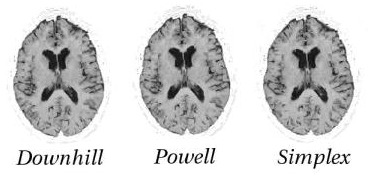 PDF version of this entire document
PDF version of this entire document
I performed many additional experiments with 8 brain images, 357x357 pixels in size each. What follows is a summary and some conclusions that I reached based on qualitative results, not quantitative.
Deciding on an Optimiser
As part of the experiments which investigate optimisation through
minimisation of the objective function, I conducted a small survey
to compare 3 methods. Figure ![[*]](/IMG/latex/crossref.png) visually
(as opposed to quantitatively) compares the level of refinement reached
using the different optimisation methods that I studied. While the
imaged brains may show similar results, the time taken to arrive at
these results varied significantly. Powell was particularly slow compared
to a simple downhill optimisation, which was used in the majority
of cases and applied at different scales5.8. In the experiments which this section will show from now on, the
only optimiser used was therefore downhill.
visually
(as opposed to quantitatively) compares the level of refinement reached
using the different optimisation methods that I studied. While the
imaged brains may show similar results, the time taken to arrive at
these results varied significantly. Powell was particularly slow compared
to a simple downhill optimisation, which was used in the majority
of cases and applied at different scales5.8. In the experiments which this section will show from now on, the
only optimiser used was therefore downhill.

|
Studying the Behaviour of Large-Scale NRR
The registration experiment that I initially ran comprised:
The results showed that improvements were first made around the skull and the ventricles. At the later stages, some improvements were also made to CSF. The duration of this experiment was under an hour on my personal computer.
In the next experiment, the rigid and affine transformation stages remained as before. At the stages of NRR (the later stages), there was a gradual increase from 1 to 5 knot-points; that is a total of 5 iterations. Another 5 iterations were run in the same manner but at a finer scale. The duration of the experiment was 15 minutes for those 20 iterations in total. The results were not as pleasing as in the previous case. CSF in particular was still fuzzy, especially once compared across images. This is not surprising considering the fact that 10 iterations of NRR were used here, compared with 90 in the previous case.
In another experiment, the optimisation regime remained the same for
the sake of consistency. To find out how an increase in resolution
affects change, the following stages of the NRR were carried out in
turn. Here is an evaluation of each of the stages (as judged by the
results through visual assessment only):
| Stage | Significance
Stage 1: Translation |
It was of course taken into consideration that bigger changes will be made at the start.